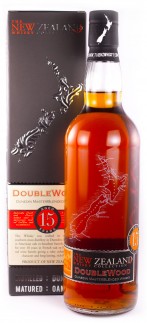26.08.14
New Zealand Whisky – Not All Black
 During the Whisky Ambassador course we do make mention of whiskies from other parts of the world. Where could be more distant from us than New Zealand?
During the Whisky Ambassador course we do make mention of whiskies from other parts of the world. Where could be more distant from us than New Zealand?
Whisky production in New Zealand is not as recent as you might think. With Scots emigrating there, it would be fair to assume that someone tried distilling – and they did, from the 1830’s. According to The New Zealand Whisky Company brochure, it kept going till the 1870’s “when onerous government regulations effectively shut it down.” ‘Twas ever thus.
Nothing much happened until the mid-20th century and, in 1974, the Willowbank Distillery was opened in Dunedin. It was later bought by Seagram, that mighty distilling name and produced a single malt called Lammerlaw. In 1997 it was sold to Foster’s, the brewers, who closed it up and sent the stills to Fiji for rum production. Bit of a lack of foresight there.
The New Zealand Whisky Company bought the last 443 casks in 2010, mainly Lammerlaw. Now they want to reopen it as their own distillery and start making fine whisky again. In order to further their ambitions, the casks they have are being bottled and sold through selected outlets. I first discovered them at an open afternoon for sampling at The Good Spirits Company in Glasgow.
The brand ambassador is Erik Burgess. He does this in his own time while also working at The Blythswood, one of Glasgow’s top hotels.
I’ve retasted 5 of the whiskies: Dunedin Doublewood (15 year old blend); South Island Single Malt (21 years old); and three of the Cask Strength collection (single casks) from 1990, 1989 and 1988. Erik tells me they are also all at natural cask colour. I asked as the Doublewood is quite dark and has that toffee note that sherry often provides. But no, it was matured 6 years in bourbon barrels then in French oak which had previously held New Zealand red wines.
These are now quite rare items, though there is more of the Dunedin Doublewood and still some South Island. A 1992 Single Cask should emerge this year and that collection will be moving to 50cl bottles to spread it more widely. A 46%abv version of Doublewood will also be released.
Overall, I got most on the nose from Doublewood, South Island and the Cask Strength 1990. The 1988 was the most closed initially but blossomed later. The Doublewood was redolent of toffee, pear drops, soft oak vanilla, cut hay, dried fruit and dark honey (manuka?). The palate showed the pear drop still but with a touch of treacle, oak tannins and citrus zest. The South Island had a real hit of banana when first nosed. There’s a little hint of smoke on the palate too. I think my favourite nose was the 1990 Cask Strength – full-on vanilla custard sweetness, baked apples and brown sugar with some sultana, soft oak and some candy sweetness, like Dolly Mixtures, though the palate was much drier.
Indeed, all were very dry finishes. Doublewood excepted, they each had a note of waxiness – either old fashioned floor polish or candle – about the nose, showing consistency of character. A couple of them, Cask Strength Single Cask from 1989 in particular, had salty notes.
All worth trying to compare with things more familiar to us. I found a couple of them less fulfilling on palate than on nose but there are plenty of Scotches like that too and it’s all down to personal taste. If you want to find out more you can contact Erik on erik@thenzwhisky.com and check out the website www.thenzwhisky.com .
Caroline Dewar
Comments